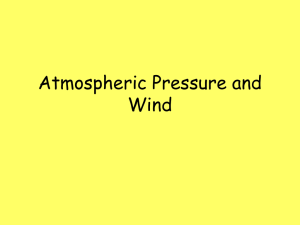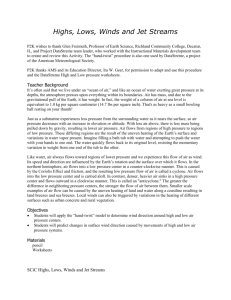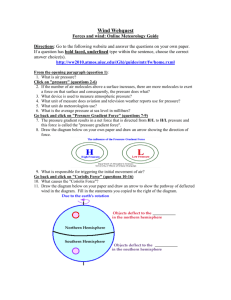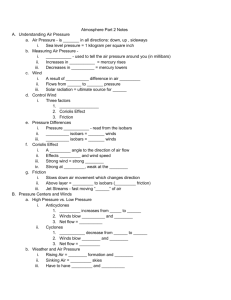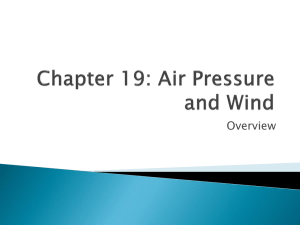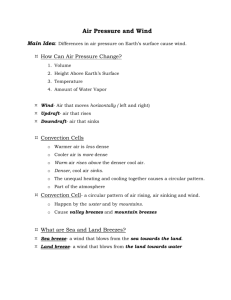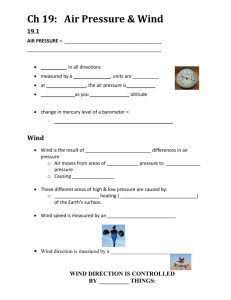slides outline
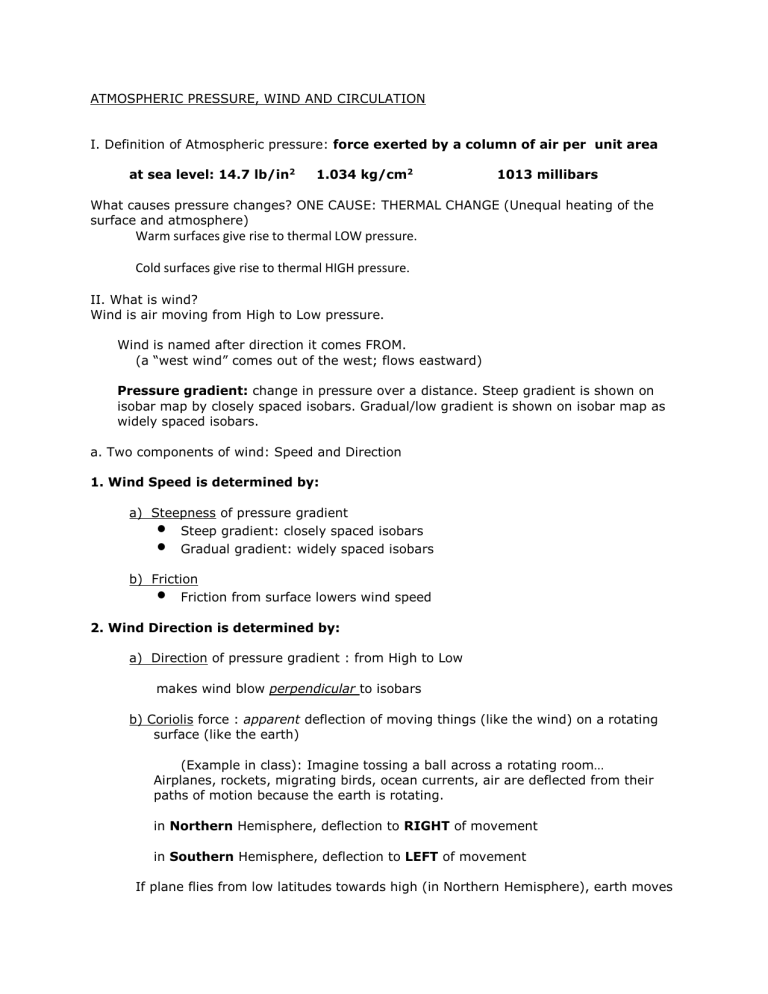
ATMOSPHERIC PRESSURE, WIND AND CIRCULATION
I. Definition of Atmospheric pressure: force exerted by a column of air per unit area at sea level: 14.7 lb/in 2 1.034 kg/cm 2 1013 millibars
What causes pressure changes? ONE CAUSE: THERMAL CHANGE (Unequal heating of the surface and atmosphere)
Warm surfaces give rise to thermal LOW pressure.
Cold surfaces give rise to thermal HIGH pressure.
II. What is wind?
Wind is air moving from High to Low pressure.
Wind is named after direction it comes FROM.
(a “west wind” comes out of the west; flows eastward)
Pressure gradient: change in pressure over a distance. Steep gradient is shown on isobar map by closely spaced isobars. Gradual/low gradient is shown on isobar map as widely spaced isobars. a. Two components of wind: Speed and Direction
1. Wind Speed is determined by: a) Steepness of pressure gradient
Steep gradient: closely spaced isobars
Gradual gradient: widely spaced isobars b) Friction
Friction from surface lowers wind speed
2. Wind Direction is determined by: a) Direction of pressure gradient : from High to Low makes wind blow perpendicular to isobars b) Coriolis force : apparent deflection of moving things (like the wind) on a rotating surface (like the earth)
(Example in class): Imagine tossing a ball across a rotating room…
Airplanes, rockets, migrating birds, ocean currents, air are deflected from their paths of motion because the earth is rotating. in Northern Hemisphere, deflection to RIGHT of movement in Southern Hemisphere, deflection to LEFT of movement
If plane flies from low latitudes towards high (in Northern Hemisphere), earth moves
more slowly at high latitudes, therefore plane appears to move more quickly eastward than the land underneath and path appears deflected to right.
Deflection increases with latitude:
no Coriolis at equator;
greatest deflection at poles
Imagine sitting on a chair on a platform at varying latitudes….
If you are sitting on the north pole, how many degrees will the room rotate/spin in one day?
If you are on the equator, how many degrees will the room rotate/spin in one day?
If you are between the poles and the equator, how many degrees will the room rotate/spin in one day?
If Coriolis effect were only influence on wind direction, wind would blow parallel to isobars. c) Friction : the “drag” produced by earth’s surface applied opposite direction of motion; reduces angle of Coriolis deflection.
1. Resulting Winds around Highs and Lows at SURFACE : Surface winds blow across isobars, towards Low pressure at an angle to the pressure gradient.
Northern Hemisphere Low: wind blows counterclockwise and in to the Low.
Northern Hemisphere High: wind blows clockwise and out of the high.
Southern Hemisphere Low: wind blows clockwise and in to the Low.
Southern Hemisphere High: wind blows counterclockwise and out of High.
2.Resulting Winds around Highs and Lows in UPPER ATMOSPHERE (UPPER
TROPOSPHERE)
(“upper” atmosphere = “aloft” = upper troposphere) no friction!; only the pressure gradient and Coriolis effect wind is parallel to isobars: GEOSTROPHIC WIND
Northern Hemisphere High: wind blows clockwise around High.
Northern Hemisphere Low: wind blows counterclockwise around Low.
Southern Hemisphere High; wind blows counterclockwise around high.
Southern hemisphere Low: wind blows clockwise around low.
3. Highs and Lows in cross-section: diagram
HIGHS: at surface produce clear skies. Rising barometer means “GOOD” weather is coming.
LOWS: at surface produce cloudy skies. Dropping barometer means “BAD” weather is coming.
III. Global Model of High and Low Pressure
a. Hadley Cells Large convective loops of circulation. Air rises at equator (or ITCZ) and sinks at Subtropics, flowing as trade winds on surface back to equator (or ITCZ). b. Equatorial Low : 5 o N - 5 o S
Intertropical Convergence Zone (ITCZ) thermal Low high sun angles, long days, available energy ascending air heavy precipitation cloud cover c. Subtropical Highs : 25 o - 40 o N & S
Excess air circulates into this zone in upper troposphere and descends descending air clear skies hot dry air great deserts here d. Subpolar Lows : 55 o - 70 o N & S warm air from low latitudes is lifted as it meets cold polar air ascending air storm centers here e. Polar Highs : 90 o thermal Highs
N & S cold polar temps at high latitudes descending air
Note: all pressure belts shift seasonally!!!
IV. Isobar Maps of Actual Pressure Centers (pp. 163)
V. Global Wind Systems / Atmospheric Circulation
a. Surface Winds
1) Trade Winds 5 o - 25 o N & S
NE Trades in Northern Hemisphere; SE Trades in Southern
steady, persistent
2) Westerlies 35 o - 60 o N & S
not steady or persistent
3) Polar Easterlies 65 o - 80 o N & S
more prevalent in Southern, variability in Northern
4) Equatorial Belt of Variable Winds and Calm 5 o
ITCZ ; “Doldrums”
N - 5 o S
5) Subtropical Belt of Variable Winds and Calm 30 o
“Horse Latitudes”
- 35 o N & S
6) Polar Front Zone 60 o - 65 o N & S
zone of conflict between differing air masses
7) Polar Zone of Variable Winds and Calm
80 o - 90 o N & S b. Winds Aloft
1)Upper Level Westerlies (25 o - 90 o )
2)Polar Low
3)Tropical High Pressure Belt (15
4)Equatorial Easterlies c. Jet Streams and Rossby Waves o - 20 o N & S)
Narrow zones of extremely high wind speeds; occur where there are strong temp contrasts.
Polar Jet (westerly)
Subtropical Jet (westerly)
Rossby Waves: undulations in Upper Level Westerlies
Summary Animation

